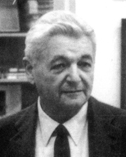

Jerrold R. Zacharias
January 23, 1905 - July 16, 1986
|
Scientific Discipline: Physics Membership Type:
Member
(elected 1957)
|
Jerrold Zacharias’s work as a physicist and educator paved the way for nuclear magnetic resonance and magnetic resonance imaging tools; international adoption of the atomic clock for standard timekeeping; new radar systems that dramatically improved surveillance capabilities; and education reform in the United States and abroad.
Zacharias studied physics as an undergraduate at Columbia University and earned his PhD from Columbia in 1931. It was the middle of the Great Depression when he finished his doctoral work, so he took a day job as a tutor at Hunter College and continued his research as a volunteer at Columbia measuring nuclear magnetic moments of various elements during nights and weekends.
Soon after the start of World War II, Zacharias worked in the Radiation Laboratory at the Massachusetts Institute of Technology (MIT) developing new radar systems. When the war ended, he took a position as director of the new Laboratory for Nuclear Science and Engineering at MIT. In the final chapter of his career, Zacharias turned his attention to establishing what became the Physical Sciences Study Committee, a body that stimulated education reform in the sciences for grade school, high school, and college students.
Zacharias was a member of numerous fraternal and scientific honor societies, including the National Academy of Sciences, the American Academy of Arts and Sciences, the American Physical Society, and the American Association for the Advancement of Science. He was a member of the President’s Science Advisory Committee and received the President’s Certificate of Merit, as well as the Department of Defense Certificate of Appreciation.

